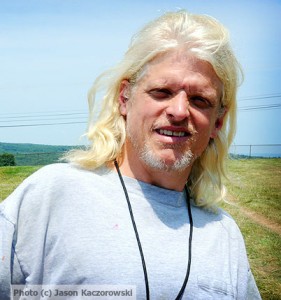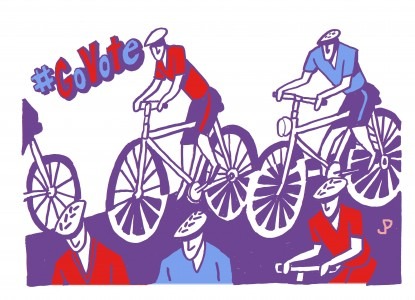Jim Pollock has been creating artwork for Phish for decades. Now he's lent his creativity to HeadCount's #GoVote campaign. Andy Bernstein, Executive Director of HeadCount, recently had a chance to sit down with Pollock to talk about his poster art, his passion for both live music and science, and how certain political issues can bridge the partisan divide.
HeadCount: Let’s start with a little backstory. How did you get started working with Phish and doing poster art?
Pollock: I went to school with those guys at Goddard College. I knew Page before he joined Phish — and then was there when he played Phish for the first time. It’s pretty cool watching the whole thing transpire. Then I moved to Chicago, and those guys would tour around. When they were in Chicago they’d crash at our apartment. And then one day they didn’t need to crash on the apartment floor anymore—they were in fancy hotels.
And when did you start making posters?
I did a couple posters for them when they used to play at Slade Hall around Burlington. Then, when I moved to Chicago, I got the job of doing a lot of T-shirt art that I made for a long time. Around ’98 or ’99 I started getting regular poster gigs. In ’98 I was starting to experiment with the linoleum prints, and I made a bunch for a UIC Pavilion show. After that, I started getting regular gigs from them doing posters and using linoleum and letter press kind of style.
 Obviously Phish fans have been big fans of your art and very supportive. What’s your relationship with the poster community, and how have you seen that develop?
Obviously Phish fans have been big fans of your art and very supportive. What’s your relationship with the poster community, and how have you seen that develop?
Oh, it’s great. I’ve always gotten a lot of support from the fans, and it’s been amazing to be able to sell art to the Internet for a long period of time and have this relationship with people that collect my stuff over the years. It’s more than any artist could ever ask for.
From time to time you’ve done art that has a statement behind it. Can you tell us about that work and the reaction that it’s gotten?
I do political ones, a lot of anti-oil, anti-petroleum things. And then also the hemp stuff too, the industrial hemp, which actually just got legalized to grow last year as part of the Farm Bill that legalized some limited growth by mostly universities for starters (for experimental crops), and then it’ll be full-on legal for agricultural use in the next few years after that. My friend, who runs an advocacy group that helps people vote for people who are supporting industrial hemp use and manufacture, has to go down to Kentucky because [Republican Senator] Mitch McConnell is the single person who pushed this through—so, strange bedfellows. Kentucky is going full steam ahead with the industrial bill.
We’re nonpartisan, so it’s always great to hear when things that are important to our community are being supported by different sides of the aisle. That’s eye-opening.
Yeah, especially with hemp and stuff, you find both sides of the aisle involved in the legislation. There’s a lot of people that will benefit—a lot of people in red states, frankly. It’s agriculture, so it’s gonna affect both sides of the political spectrum—but all beneficially, making for a better economy.
Speaking of politics, can you tell us about the #GoVote art piece that you did for our campaign?
I kind of wanted to do the positives so they’re riding bikes; they’re not riding cars. But it’s still a race. It’s the red against the blue jerseys. I’m pretty up front about my political beliefs, but I like to see a good race. I’d like to see both parties thrive and to have more parity.
Do you believe that art has a sort of unique power to motivate people and to open eyes and to lead people toward a path of consciousness and participation?
Yeah, I hope so. Sometimes I think a lot of the stuff I do that’s political is almost cathartic: there’s nothing I can do; I just have to get it out of my head, and it’s the best way. But I also like to do more positive things. There’s obviously a lot of powerful aspects to art, but people have to come to consciousness, too, so it’s a combination of those things. But it’s helpful, especially with a multicultural world and people of different languages: art a lot of times can say universal things.
What art and music inspire you these days?
Live music. And it’s part of the reason I like to do the printing. I see a lot of jazz in Chicago, and also standup comedy, but I like to see live music happening. I feel like recently there’s a lot more interesting live music venues and music genres that have appeared. The whole bluegrass thing seems to be unique, and people do it using more acoustic, less plugged-in stuff. There’s a lot of interesting stuff going on. I’ve seen the Milk Carton Kids a couple weeks back at Old Town School of Folk Music. That’s a really great sound. And then the art: I look at a lot of books. And science. Science is probably the biggest thing that feeds my head; that’s what I mostly read.
What kind of science?
History of science. And that’s led me to more recently the Golden Ratio and the Golden Mean, so I’ve been exploring that kind of stuff. It’s all science that this whole notion that we’re heating up the earth is based on, so I’ve been fascinated by that for years. If you read about the history of science you notice that there’s a constant pushback against new ideas about how the world is based on scientific premises, and how it’s always fought; it’s never easy.
